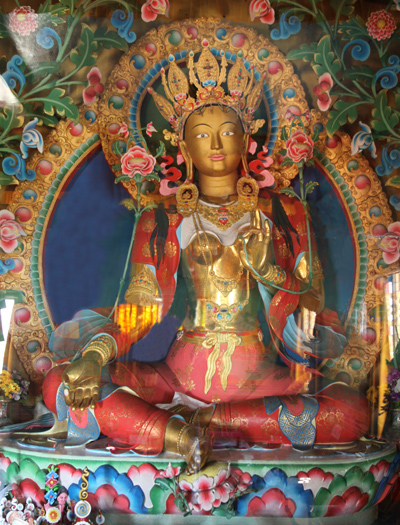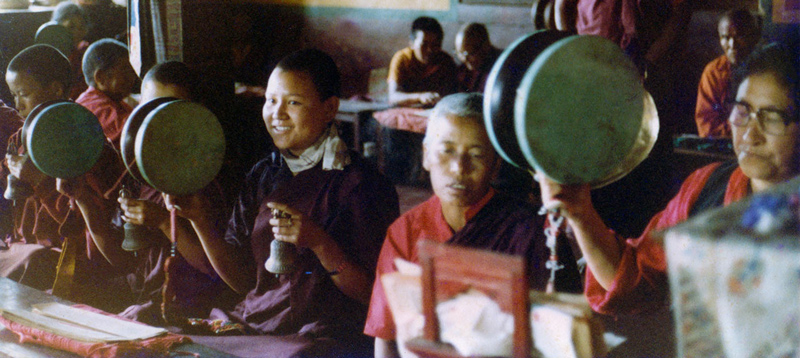Monastic life
The Nuns’ Daily Schedule at Nagi Gompa Hermitage

Monday – Friday at Nagi Nunnery:
5:30-7:00 a.m. Morning group practice in the tsokkhang (temple) for all except for those nuns in the
Elementary School program.
5:30-6:30 Elementary Program of First-Year nuns learn to read Tibetan Uchen script, a traditional
script of Dharma study and practice texts.
Elementary Program of Third-Year nuns memorize morning group-practice texts and
practice pronunciation and speed.
(There are no Year Two nuns due to Nepal’s 7.8 earthquake in 2015.)
7:00 a.m. Breakfast
8:00-9:30 a.m. Elementary Program First Year continues learning to read Tibetan Uchen script.
Elementary Program Third Year demonstrates memorization of morning group-
practice texts.
Middle School First Year studies over 3 months How to Listen to the Dharma, by Khenpo
Kunzang Palden, a portion of his commentary to Entering the Way of
the Bodhisattva and The 37 Practices of a Bodhisattva by Gyalse Togme;
next 3 months. Tree of Excellence by Yangchan Dorje; then 2 months
Spelling for Children by Tendzin Namgyal.
First-Year Shedra Class studies Shantideva’s Entering the Way of the Bodhisattva
(Bodhicharyavatara) over four months which is followed by Mipham Rinpoche’s Gateway to Knowledge (Kenjuk) Vol. 1 over four months.
10:00-11:15 a.m. Elementary Program First Year continues learning to read Tibetan Uchen script.
Elementary Program Third Year reads the Life of Padmasambhava by Yeshe Tsogyal and
discovered by Urgyen Lingpa to develop recitation skills and
comprehension.
Middle School First Year learns how to create ritual offerings such as torma and play
ritual instruments.
First-Year Shedra Class studies the Types of Reasoning (Tag-rig) by Khenpo Tsondru,
instructions in Buddhist philosophical debate for four months followed by The Commentary to the Thirty-Verses by Thonmi Sambhota and Karma Situ, the Sambhota system of grammar over four months.
11:30 a.m. Lunch
1:00-1:45 p.m. Elementary Program First Year studies the large-format calligraphic script of Tibetan,
Ume, which is used for banners and other large surfaces.
Elementary Program Third Year studies Tibetan in the small Ume script, a traditional
script for Dharma texts.
Middle School First Year studies Nepali.
First-Year Shedra nuns engage in self-study in their room.
2:00-4:00 p.m. First-Year Shedra continues study of The Way of the Bodhisattva and Gateway to
Knowledge.
2:00-2:45 Elementary Program First Year studies English basics.
Elementary Program Third Year studies Nepali.
3:00-3:45 Elementary Program First Year studies Nepali basics.
Elementary Program Third Year studies English.
1:45-2:30 Middle School First Year studies English.
2:30-4:00 Middle School First Year nuns engage in self-study of texts and language in their rooms.
4:00-5:30 p.m. Afternoon group practice in tsokkhang for all nuns except those in the Elementary
School program.
4:00-5:00 Elementary Program First Year studies Tibetan in Uchen.
Elementary Program Third Year continues study of The Life of Padmasambhava.
6:00-7:00 p.m. Elementary Program First Year learns to write the large Ume script
Elementary Program Third Year studies the small Ume script.
Middle School First Year nuns engage in self-study in their room.
First-Year Shedra practices debate in the courtyard of the nuns’ residence
opened in 2015.
7:00 p.m. Dinner time for those nuns not in retreat. (Evening retreat session begins at 7 p.m.)
8:00-9:00 p.m. Elementary Program First Year does homework and reading in class setting.
Elementary Program of Third Year does homework and reading in class setting.
8:00-10:00 p.m. Middle School First Year nuns engage in self-study in their room.
First-Year Shedra nuns engage in self-study in their room.
Saturdays and Sundays at Nagi Nunnery:
Every day of the year, morning and late-afternoon group practice takes place at Nagi Gompa in the tsokkhang. Saturday morning classes are the same as on weekdays. In the afternoon, nuns clean their classrooms. Sometimes there is a one-hour class by the resident Khenpo and Lopon as well as senior nuns and visiting senior monks in details of monastic behavior and excellence and the exemplary life examples of great masters. There are no classes on Sunday.
Through its 50-plus year history, the Nagi Gompa Hermitage has the been the site of intensive Dharma practice.
Lineages Practiced:
Lineage is extremely important in the Vajrayana, Dzogchen and Mahamudra traditions.
Those practiced at Nagi Gompa are lineages with a very short, intimate line, qualities considered especially powerful for practice results.
Chokling Tersar:
Kyabje Tulku Urgyen Rinpoche’s grandmother was the daughter of Chokgyur Linga, the Nyingma terton who revealed the Chokling Tersar cycle of teachings and practices performed daily at Nagi Gompa, and begun under Kyabje Tulku Urgyen’s teaching and supervision. Kyabje Tulku Urgyen and his father, grandmother and uncle Samten Gyatso practiced the Chokling Tersar.
Samten Gyatso was Rinpoche’s root guru. Rinpoche’s grandmother was regarded as a supreme practitioner of the Chokling Tersar Tara practice, Zabtig Drolma, having directly realized this deity (yidam) practice. (yidam, one who “binds” the practitioner’s mind to its realized essence)
Nyingtik:
The Nyingtik of Jigme Lingpa was established at Nagi Gompa by Karsha Rinpoche, who preceded Kyabje Tulku Urgyen Rinpoche and held a very short lineage through a heart-son of Sakya Shri, the guru of Jigme Lingpa. For this reason, Kyabje Tulku Urgyen kept these practices at Nagi Gompa when he became head of the community in 1960. (’64?)
Chod (The practice of offering the body to realized beings and those who are suffering):
Kunzang Dechen, the wife of Kyabje Tulku Urgyen Rinpoche and mother of Chokyi Nyima and Chokling Rinpoches, was an eminent chod practitioner. She trained Nagi nuns in the profound meaning of the Tsogyle Rinchen Trengwa chod liturgy and use of the chod drum. Kunzang Dechen received her training at the Shukseb Nunnery in Tibet, one of the most important sites for chod practice in its day and the seat of Jetsun Rigdzin Chonyi Zangmo, reincarnation of the great Machig Labdron whose name is synonymous with chod.
Dzogchen and Mahamudra:
Kyabje Tulku Urgyen’s family all practiced Dzogchen. His grandfather also held the Tsangsar Barom Kagyu lineage from Milarepa. This Mahamudra lineage was deeply integrated in Kyabje Tulku Urgyen’s style of teaching Dzogchen preliminaries to local and international students, with – among other approaches — the Four Dharmas of Gampopa as the starting point for learning, reflecting and meditating.

The Tradition of Tara at Nagi Gompa:
Two exceptional influences laid a foundation for excellence and accomplishment of the practice of Tara at Nagi. First was the very special connection through Kyabje Tulku Urgyen’s grandmother with the Tara practice of Zabtig Drolma — a revered practice of Tara in the Tibetan tradition. Kunzang Dechen, Rinpoche’s wife and an advanced practitioner, practiced Zabtig Drolma (Tara) intensively and inspired the nuns by practicing alongside them over many years. One can also speculate about the strength of practice of a female Buddha by a female community. Nearby Tara Mountain, believed to have been blessed by Tara, has created another connection between the nuns and yidam Tara.

The Tradition of Chod – the Practice of Offering the Body:
Chod is a Vajrayana practice on the nature of ultimate reality — emptiness and dependent origination. The practitioner meditates on the profound meaning and visualizes offering her or his transient body to realized beings and those who are suffering.
Over many years Kunzang Dechen, Kyabje Tulku Urgyen’s wife and a highly accomplished Chod practitioner, was an inspiring example for the nuns at Nagi Gompa. She instructed the nuns and practiced alongside them.
Chod practice at Nagi originated in Kharsha Rinpoche’s day. Nagi’s oldest nun, Tashi Drolma, now in her early 90s, recalls being sent from Nagi with other members, her Chod drum and bell in hand, performing Chod as she walked toward the southwest of the Valley to Pharphing bringing an experience of the Dharma to local people along the way.
Today, the nuns practice seven different Chod of which three are from the Chokling Tersar: a concise, medium and long version. These three are mostly practiced in three-year retreat; the short chod is used especially in ceremonies in private homes during illness. The Nyingtik Khadro of Jigme Lingpa and the Tsogyle Rinchen Tengwa of the Third Karmapa are practiced in the tsokkhang on Tibetan 25th, Dakini Day. The Nyingtik’s short Khandro Gegang concludes the Nyingtik Chod dance (cham) when it is performed. A short chod from the Nyingtik lineage, Changbu Gyatsa, also is practiced especially during illness.
Increasingly, Nagi nuns have been called to teach and demonstrate Chod practice for Nepali and international lay students. The easy-to-understand lyrics and pleasant melody make chod practice highly accessible for many lay people. Offering one’s body is an especially meritorious aspiration and a skillful method to help us cut ego attachment. We imagine “cutting” and offering the outer body to help us transcend our inner ego clinging, our ignorance and to realize instead the true nature of reality.

Nagi nuns are well-known locally and in some Dharma centers abroad not only for their Chod, but also for their Chod dance (cham). Historically, Vajrayana dances have been performed by monks, so the Chod Cham is a rarity. Dharma dances have been created by realized lamas who have directly seen the movement of realized awareness revealed by yidams (meditation deities) and dakinis (realized female deities) in pure lands.
Young nuns at Nagi learn to perform this complicated dance that requires carefully choreographed moves while playing the Chod drum and bell and singing the practice’s haunting melody and lyrics. Later, chod practice is continued in retreat to refine a nun’s meditation on the profound meaning.